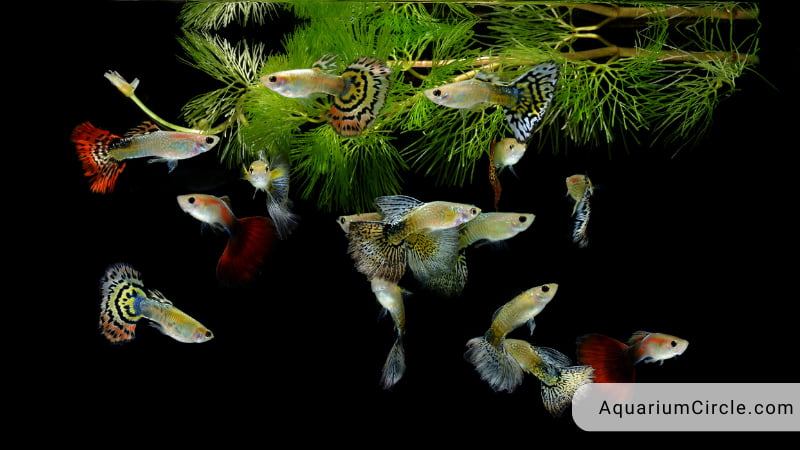Guppies, known for their vibrant colors and lively personalities, are a popular choice among aquarium enthusiasts. While these small, tropical fish are relatively low-maintenance and beginner-friendly, it’s essential to choose the right tank mates to ensure a harmonious and thriving aquarium environment. Selecting compatible tank mates not only enhances the visual appeal of your aquarium but also contributes to the overall health and well-being of your guppies.
In this blog post, we will explore the factors to consider when choosing guppy tank mates, discuss ideal companions, and provide insights on how to maintain a peaceful aquatic community. So, get ready to create the perfect underwater haven for your guppies and their new friends!
See also:
- Yin Yang Guppy Fish: The Most Feature Which You May Not Know
- 3 Things About Dumbo Guppy Fish That New Aquarists Need To Know
- Top 13 Long Tail Beautiful Guppy Fish Make You Fall In Love
23 Best Tank Mates For Guppies
Fish should coexist harmoniously with their tank mates, without being subjected to bullying, injuries, or stress caused by sharing an aquarium with incompatible species.
Although sharing similar water conditions is an essential criterion for determining whether two types of fish will get along, other factors must be considered when selecting the ideal tank mates.
As such, the most suitable tank mates for guppy fish are those that:
- Thrive in the same water conditions as guppies;
- Exhibit peaceful behavior and have no known significant issues;
- If displaying any behavioral concerns, these can be easily managed or mitigated;
- Are of a similar size or, if there is a size discrepancy, it’s not significant enough for one fish to mistake the other for prey;
- Have dietary preferences similar to guppies or can flourish on a comparable diet.
Any fish that poses a threat to the well-being of your other fish should be ruled out as a potential tank mate.
We have summarized 23 best guppy tank mates that you can consider for your fish tank below:
Platy fish
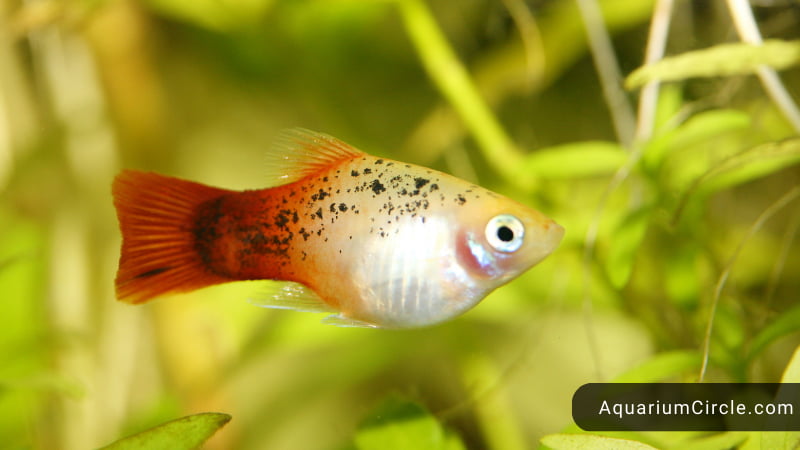
Platy fish can live with guppies as they make great tank mates. Both species share similar water requirements and are known for their peaceful and social nature. They also have comparable diets, which consist primarily of flake foods and occasional live or frozen foods like brine shrimp or daphnia.
Platy fish are livebearers like guppies, and they coexist well in community tanks. However, it is essential to monitor the tank’s population since both species can reproduce rapidly. To manage this, you can either limit the number of males and females of each species in the tank or provide adequate space for their offspring.
Neon Tetras
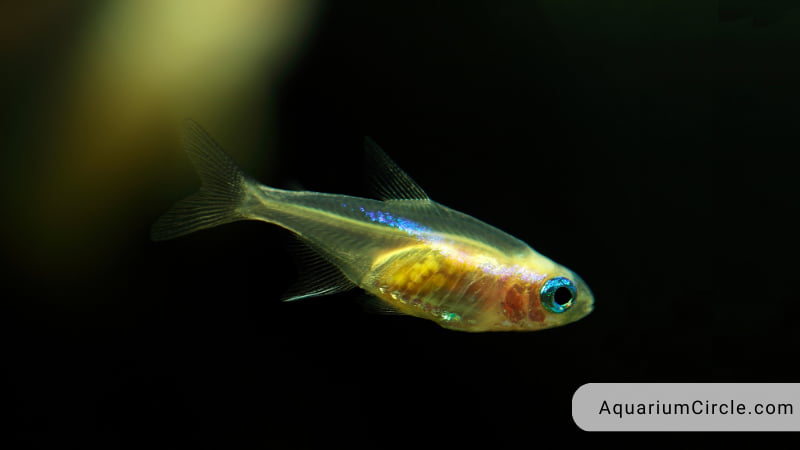
Similar to guppies, Neon Tetras are small, peaceful fish known for their striking colors. When housing these two fish together in the same tank, these species can create a visually stunning display. As schooling fish, Neon Tetras should be kept in groups of six or more to ensure their comfort and well-being.
Neon Tetras are less active than guppies, so it’s crucial to provide a spacious tank to prevent the more energetic guppies from causing constant stress to the Neons. A tank of at least 20 gallons is recommended to accommodate both species comfortably and allow them to coexist harmoniously.
Molly fish
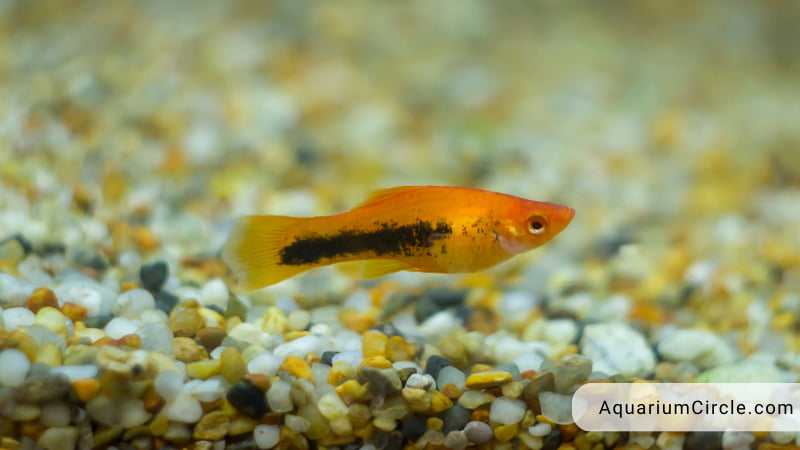
Molly fish make an outstanding choice as tank mates for guppy fish, as they are also live-bearing freshwater species that are both hardy and suitable for beginners.
With their peaceful demeanor, Molly fish flourish in water conditions similar to those favored by guppies. They also thrive on a diverse, omnivorous diet, just like guppies.
In addition, Mollies are compatible with other guppy-compatible fish such as platies, harlequin rasboras, and bristlenose plecos. This compatibility simplifies the process of establishing a mixed-species aquarium for hobbyists.
Swordtail fish
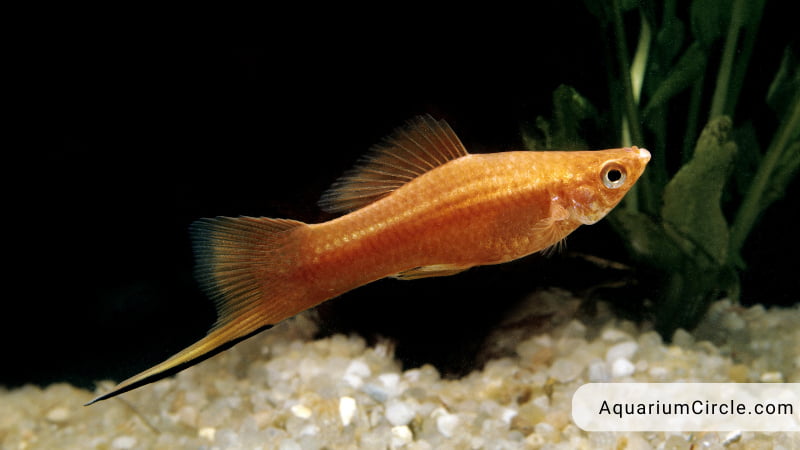
Swordtails and guppy fish make an excellent pairing, scoring a perfect 10/10 compatibility. Swordtails are characterized by their unique shape, featuring an elongated bottom fin that resembles a sword, and they come in a variety of colors.
Since both guppy fish and swordtail fish are known to jump out of their tanks, it is crucial to have a secure cover in place to prevent any unfortunate incidents.
Similar to guppies, swordtails enjoy being part of a group. However, it is essential to be mindful of the female-to-male ratio, as both species are known for their prolific breeding, which can quickly lead to an overpopulated tank.
Cory catfish
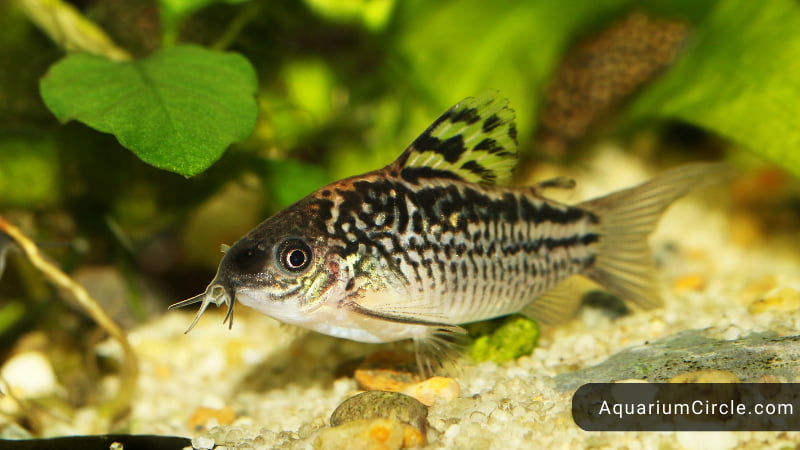
Cory catfish, exceptional scavengers and tank cleaners, are bottom dwellers that coexist harmoniously with guppies and numerous other freshwater fish.
Their amiable behavior and peaceful temperament make them an excellent choice for beginner aquarists, as they are not picky eaters and do not require special care.
While Cory catfish scavenge leftover food from the tank’s bottom, their diet should not consist solely of leftovers. Provide sinking foods to supplement their nutrition.
Although they are bottom dwellers, Cory catfish have delicate barbels that can be injured by rough substrates, such as gravel. As a safer alternative, consider using sand in your aquarium.
Bristlenose Pleco
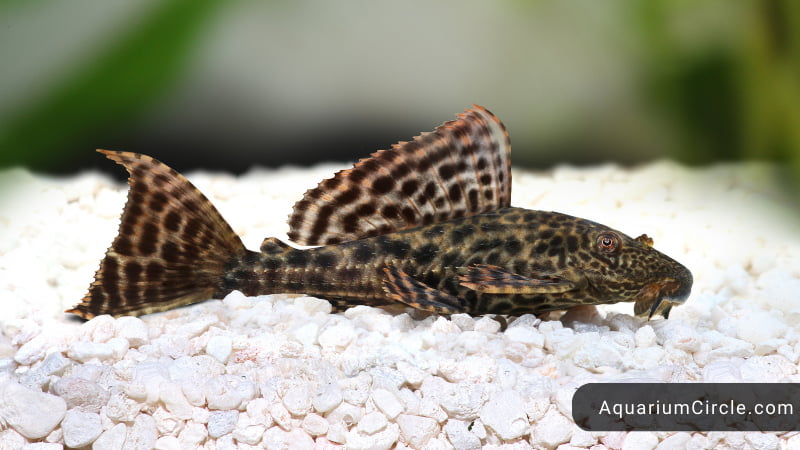
The fleshy tentacles adorning Bristlenose plecos, which inspired their name, may not appeal to every aquarist, but some find them intriguing.
Regardless of personal aesthetic preferences, Bristlenose plecos’ exceptionally peaceful temperament makes them an ideal choice for sharing a tank with guppy fish.
As bottom-dwellers, they excel at cleaning the aquarium and generally occupy different areas of the water column than guppies.
Although Bristlenose plecos grow larger than guppy fish, necessitating a more spacious tank, a 30-gallon aquarium typically provides an ideal environment for these fascinating creatures.
Honey Gouramis
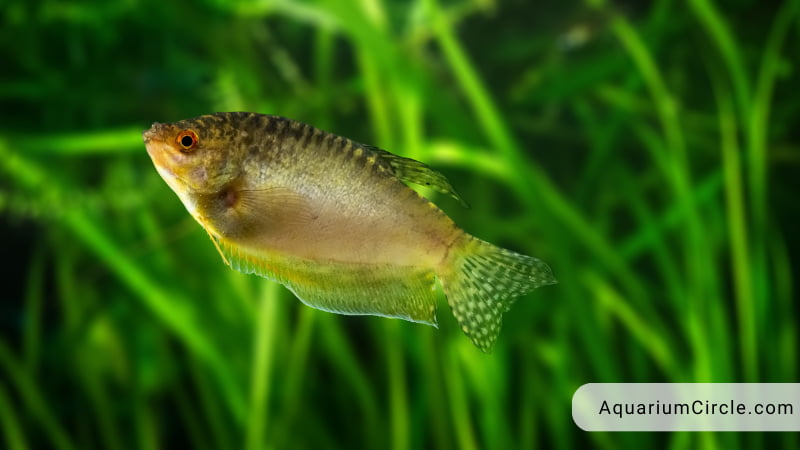
We’d like to begin by noting that Honey Gouramis are high-maintenance, and I wouldn’t recommend them for complete beginners.
Successfully keeping Gouramis entails adhering to specific requirements, so they are better suited for more experienced aquarists or those who don’t mind the potential challenges associated with this species.
Firstly, they should be kept in groups of 4 to 6, as they are social fish that flourish in groups. Consequently, a small tank isn’t a suitable option for them.
Additionally, they require planted tanks that provide ample shade and numerous hiding spots. Aquarists often use floating plants to mimic the natural shaded environment in which they thrive.
Though they are somewhat timid, Honey Gouramis are non-aggressive and make excellent companions for Guppy fish.
In their natural habitat, they primarily consume insects and their larvae. However, in aquarium settings, they readily accept various types of frozen or live food.
Dwarf Gouramis
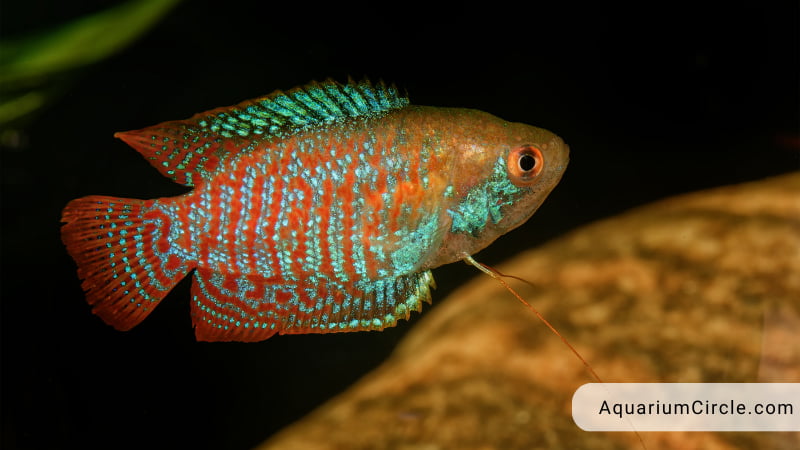
Dwarf Gouramis can live with Guppy fish, as both species are generally peaceful and can coexist well in a community tank. They share similar water requirements, with a preference for slightly acidic to neutral water conditions and temperatures between 72°F to 82°F (22°C to 28°C). However, there are some essential considerations to ensure their compatibility such as: size of the tank, hiding spots and plants, tankmates and diet…
Harlequin Rasboras
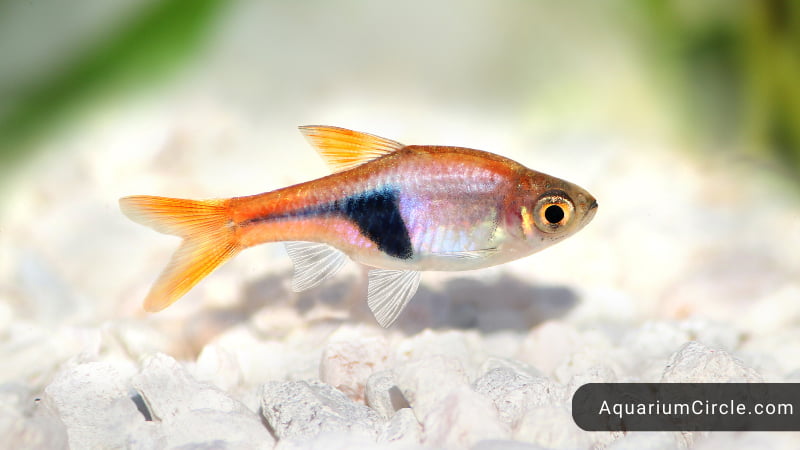
Harlequin rasboras are a community-friendly, beginner-friendly, and easy-going freshwater fish that make excellent tank mates for guppies.
These vibrant fish are characterized by their copper-red color, accentuated by a distinctive triangle-shaped patch on the rear end of their body.
As schooling fish, Harlequin rasboras thrive in groups of 8 to 12. Maintaining them in smaller groups of 3 or 4 may result in timidity or stress.
They coexist peacefully with guppies and other freshwater fish like Cory catfish and cardinal tetras.
Both Harlequin rasboras and guppies prefer the top to mid-levels of the tank, but you can expect minimal territorial behavior or tension between the two species.
It’s essential to avoid housing them with large or predatory fish, as this can lead to conflicts.
To keep Harlequin rasboras healthy and happy, provide a varied diet that includes fresh, dried, frozen, and flake foods. Despite being undemanding, a diverse diet ensures optimal health and vibrancy for these fish.
Betta fish (female betta)
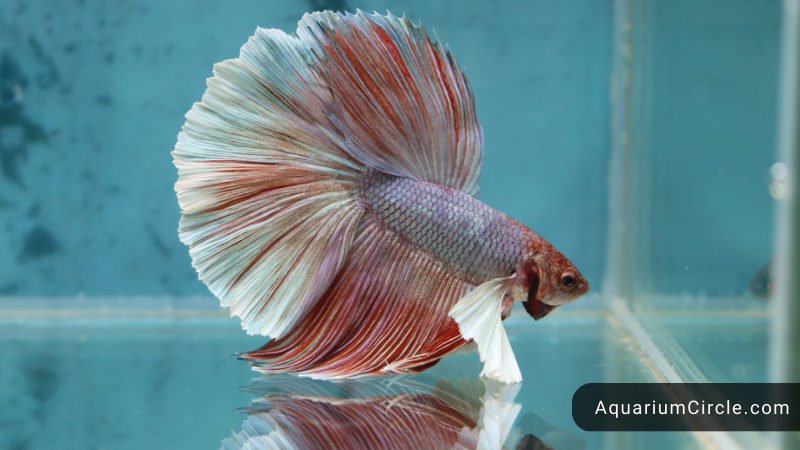
Betta fish (Betta splendens) are a popular type of freshwater fish found in the wild in various locations and commonly available in pet stores.
Known for their striking colors and patterns, betta fish are a popular choice for aquarium enthusiasts. However, their vibrant appearance can fade if they are not cared for properly.
Bettas thrive on a specialized diet that includes live foods such as brine shrimp, worms, and bloodworms. Additionally, they need a heated tank with a minimum of 5 gallons of water.
When considering betta fish as tank mates for guppies, it’s advisable to choose female bettas. Male bettas can be aggressive, while females tend to be more peaceful and less likely to eat your guppy fry.
By selecting female betta fish, you can create a more harmonious environment in your aquarium, allowing both species to coexist without undue stress or aggression.
Siamese Algae Eater
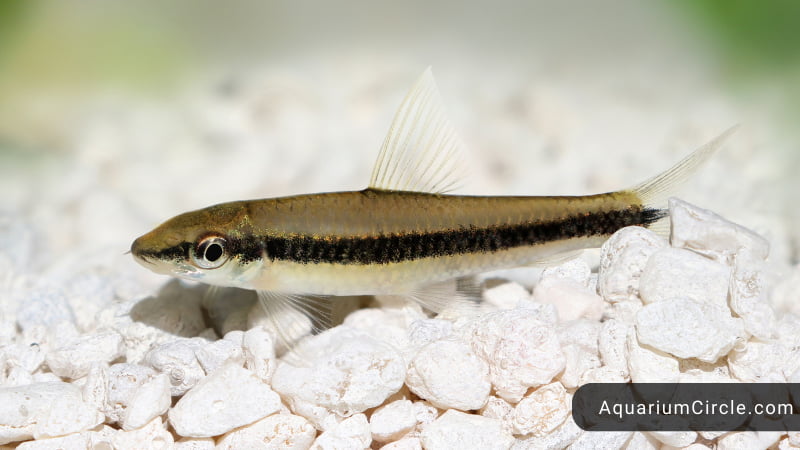
The Siamese Algae Eater (Crossocheilus oblongus) is a freshwater fish native to Asia, which has been introduced to various regions, including North America, Australia, Africa, and Japan.
This species is popular among aquarium enthusiasts for its vibrant colors and exceptional algae-eating abilities. In contrast to other algae eaters, Siamese Algae Eaters are more active in aquariums.
Though they can explore the entire aquarium, they typically spend their time at the bottom, consuming algae and searching for additional food sources, such as live food and insects on the tank substrate.
A planted tank is optimal for their growth and well-being. These peaceful fish can be housed with guppies, tetras, and danios without any issues. Siamese Algae Eaters are relatively small and widely available in pet stores across the globe.
Otocinclus fish
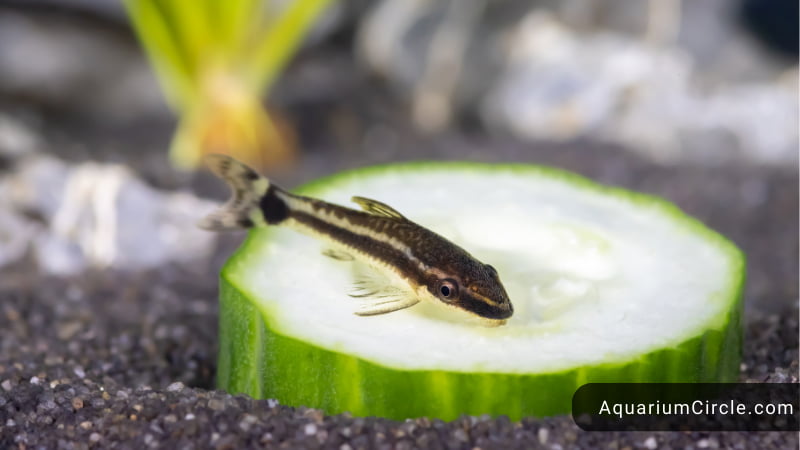
Otocinclus fish are another excellent algae-eating option for a guppy aquarium. These swift swimmers have an unrelenting appetite for algae, making them a valuable addition to your tank.
However, Otocinclus fish are more sensitive to suboptimal water conditions than guppies, so it’s crucial to maintain pristine water parameters when housing these two species together.
Additionally, monitor the tank dynamics, as guppies may exhibit fin-nipping behavior when sharing their habitat with Otocinclus fish. Ensuring a harmonious environment will promote the well-being of both species.
Danios
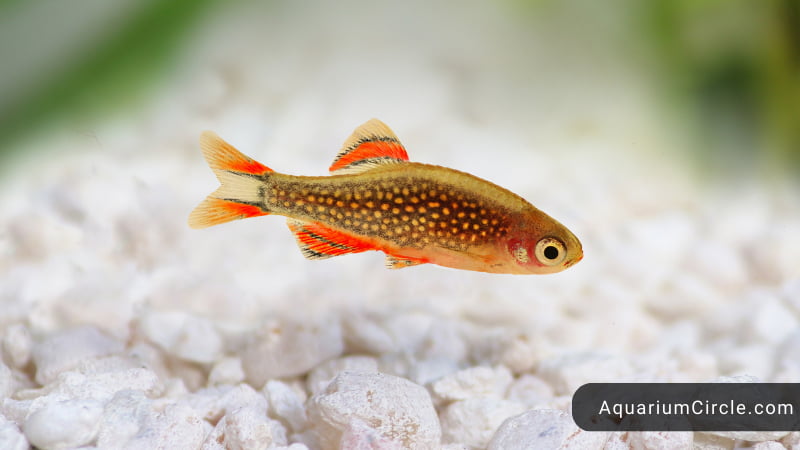
Danios (including Zebra fish, Pearl Danio, Danio Kerri, and Queen Danio) are another potential set of good tank mates for guppy fish. They are not aggressive towards each other and thrive in the same water parameters.
One challenge with this combination is that Danios are quicker at reaching food than guppies, which could leave some guppies hungry.
To ensure equal access to food, aquarists recommend distributing food at various locations within the tank. Additionally, consider introducing scavenger fish into the aquarium to help consume any leftover food. This approach will create a more balanced and harmonious environment for all the fish in your tank.
Rainbowfish (Boeseman’s)
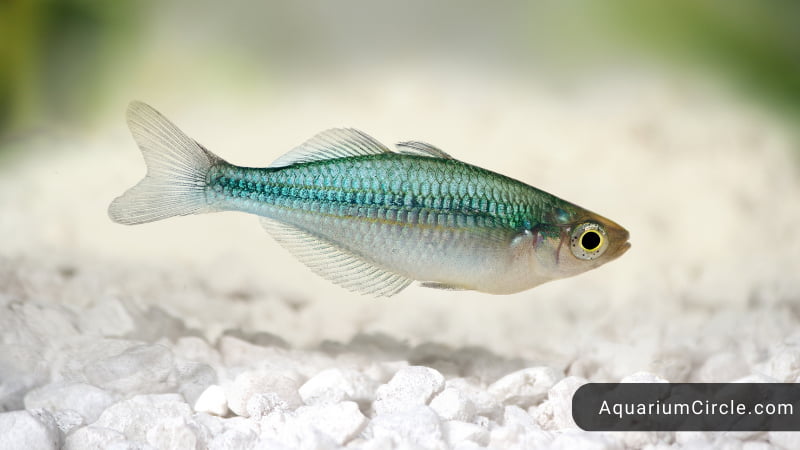
Boeseman’s Rainbowfish, a beautiful and popular freshwater fish, can be a suitable tank mate for guppies. However, as they are schooling fish that grow larger than guppies, it is essential to provide them with a spacious aquarium.
These fish appreciate a densely planted environment and will accept a variety of fish foods, including live foods that enhance their stunning colors.
Rainbowfish are durable, easy to keep, and moderately hardy, making them adept at resisting diseases.
As active swimmers exhibiting schooling behavior, it’s crucial to house them in an appropriate tank size: at least 50-60 gallons to ensure their well-being and promote a harmonious coexistence with guppies.
Ram Cichlids
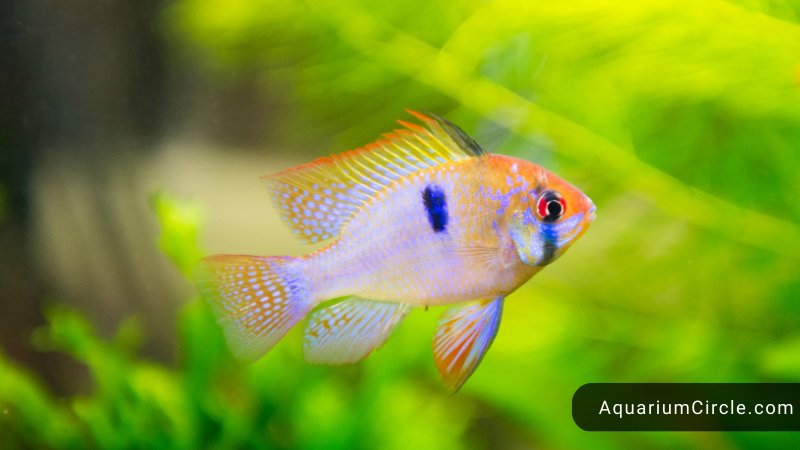
Cichlids are known for their aggressive nature, but some dwarf varieties, like Ram Cichlids, are considerably more peaceful than their relatives, making them suitable tank mates for guppies.
These fish boast vibrant colors, with iridescent bodies and high fins. They remain relatively small, thriving in tanks that are at least 12 gallons in size.
Ram Cichlids can coexist with other live-bearing fish compatible with guppies, such as swordtails, mollies, and platies.
As one of the few cichlids that can live harmoniously with small livebearers, Ram Cichlids are not difficult to maintain. However, breeding them can be more challenging compared to other livebearers.
Bronze Corydoras
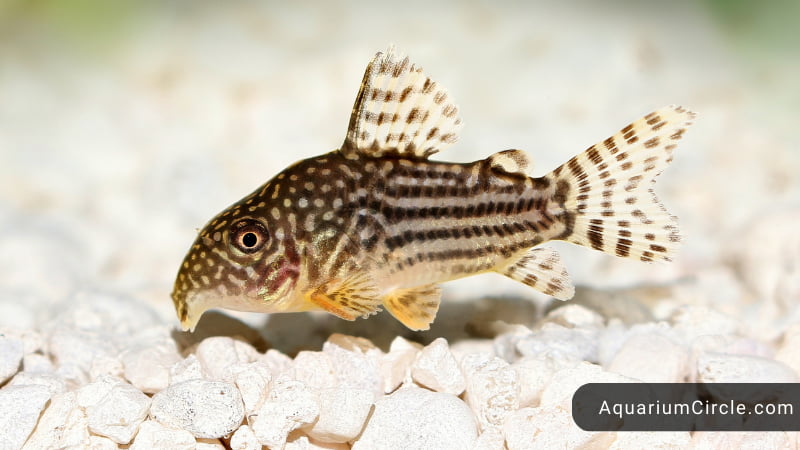
The resilient and low-maintenance Bronze Corydoras can coexist with guppies seamlessly. We recommend housing them in groups and providing ample food.
Though they might appear unremarkable at first, Bronze Corydoras can be appealing guppy tank mates. Their scales exhibit green and pink hues, adding a touch of color to your aquarium.
As bottom-dwelling fish, they can adapt to a variety of environments and water conditions, making them an excellent, hassle-free addition to your guppy tank.
Endler’s Livebearers
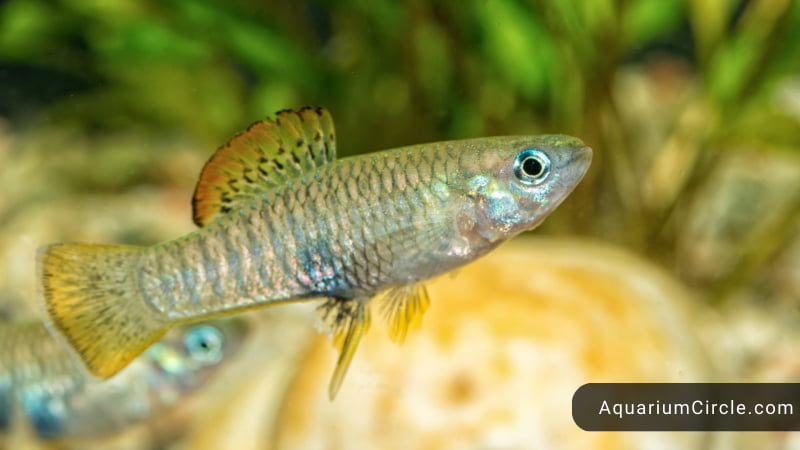
Endler’s Livebearers (Poecilia wingei) are small, vibrant fish that actively swim around the aquarium, coexisting well with guppies and other fish.
Avoid housing them with larger fish, as their lively nature might make them appear as targets. They are compatible with guppies in terms of pH and temperature requirements.
One potential issue is crossbreeding between the two species, which can lead to offspring with health problems. To prevent this, consider keeping tank mates of the same gender.
If you decide to have both females and males, be aware that females can be more territorial. To minimize aggression and potential conflicts, maintain a ratio of three female fish to one male. This arrangement should work well for a harmonious tank environment.
Zebra Danio
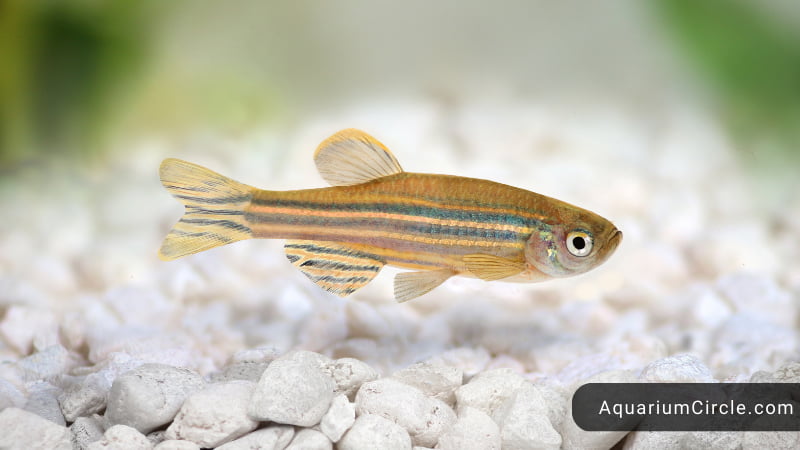
Danios, including Danio Kerri, Zebra fish, Queen Danio, and Pearl Danio, are all excellent tank mates for guppies. They generally share similar water parameters and do not exhibit aggressive behavior towards one another. One popular choice is the Zebra Danio (also known as Zebra fish).
Zebra Danio (Danio rerio) is a friendly and swift-swimming species native to Bangladesh and India. It is characterized by its horizontal, elongated stripes, which inspired its name.
These active, captive-bred “zebras” can grow up to 2 inches in length and are often used as dither fish in aquariums. They are adaptable to various conditions and water parameters, requiring no special care.
Though these fast swimmers coexist safely with guppies, they tend to find and consume food more quickly. To ensure your guppies don’t go hungry, be sure to provide enough food for all the fish in the tank.
Kuhli loaches
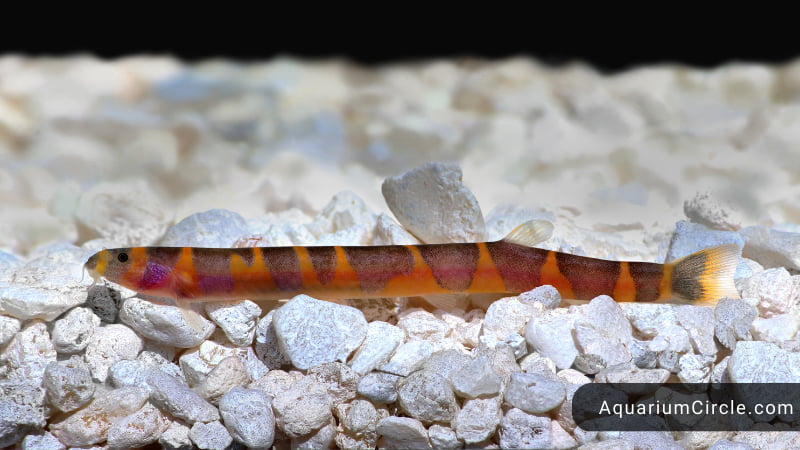
Kuhli loaches are peaceful, nocturnal bottom-dwelling fish, while guppies are active during the day and swim in the middle to top levels of the tank. This difference in activity patterns and tank levels means they generally won’t compete for space or resources.
Both species prefer similar water conditions, with a pH range of 6.0 to 7.5 and temperatures between 72°F to 82°F (22°C to 28°C). However, Kuhli loaches appreciate a softer substrate, like sand, as they like to burrow and hide during the day. Providing hiding spots with plants, rocks, and caves can also help Kuhli loaches feel more secure in the tank.
When choosing tank mates for guppies, it’s essential to avoid any fish species that may exhibit aggressive or predatory behavior. Kuhli loaches are a good choice as they are peaceful and will not bother guppies or other small fish in the aquarium.
Red Cherry shrimp
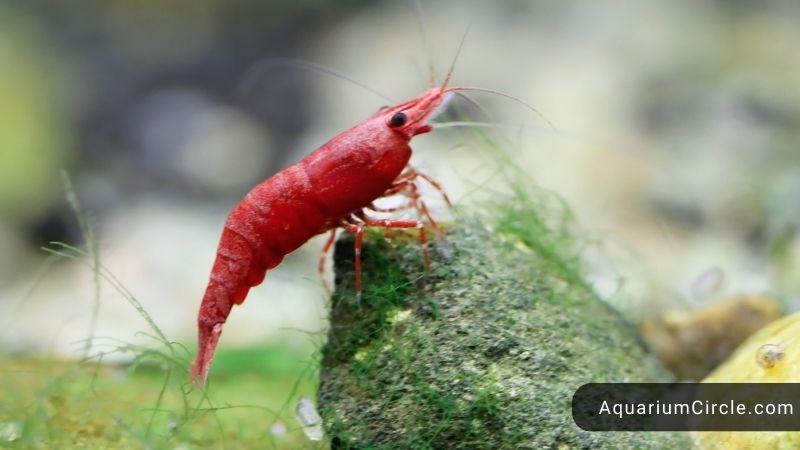
If you’re open to considering non-fish tank mates for your guppies, Red Cherry Shrimp can be an excellent addition to a freshwater aquarium with guppies.
What makes them a suitable choice? First, guppies typically don’t prey on newborn Cherry Shrimp. However, it’s still a good idea to introduce fully grown shrimp as a precaution.
These prolific breeders actively explore their surroundings, feeding on food particles and decaying plant matter. To ensure a balanced diet, offer them both processed foods and fresh vegetables.
Red Cherry Shrimp reproduce quickly and aren’t picky about their environment. They also thrive in the same tank conditions as guppies, making them an ideal choice for novice aquarists.
See also: Crystal Red Shrimp Care Guide – New Pet Unlock
Amano shrimp
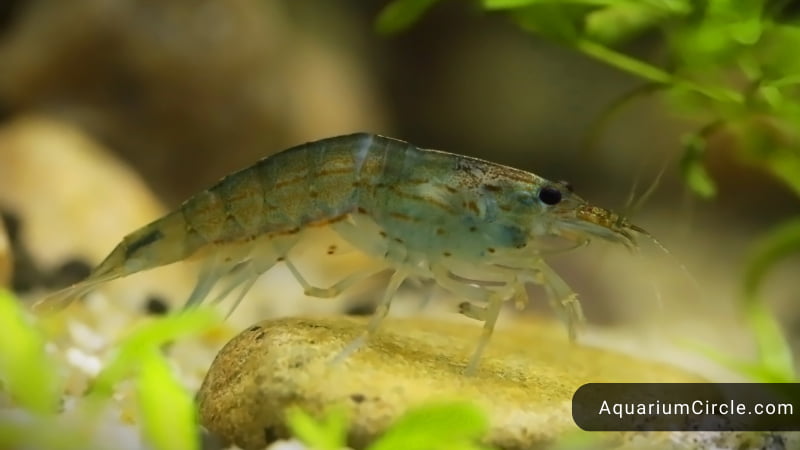
Amano Shrimp (Caridina multidentata) are peaceful creatures that can coexist harmoniously with guppies in your aquarium.
These lively bottom-dwellers add vibrant color to fish tanks and are not aggressive or predatory towards fry.
Reaching up to 5 cm (two inches) in length, they don’t require much space, but a 10 gallons tank is recommended.
Amanos typically spend their time at the bottom of the tank, consuming nuisance algae and scavenging for leftover food. Be aware that they may snatch food from fish and other tank inhabitants.
Ensure their diet is well-balanced with pellets, flakes, and vegetables, as well as live and frozen food for optimal health.
It’s also important to provide ample plant cover in your aquarium to facilitate molting. Additionally, create hiding places in your tank, as Amano Shrimp enjoy concealing themselves and are quite adept at it.
Nerite snails
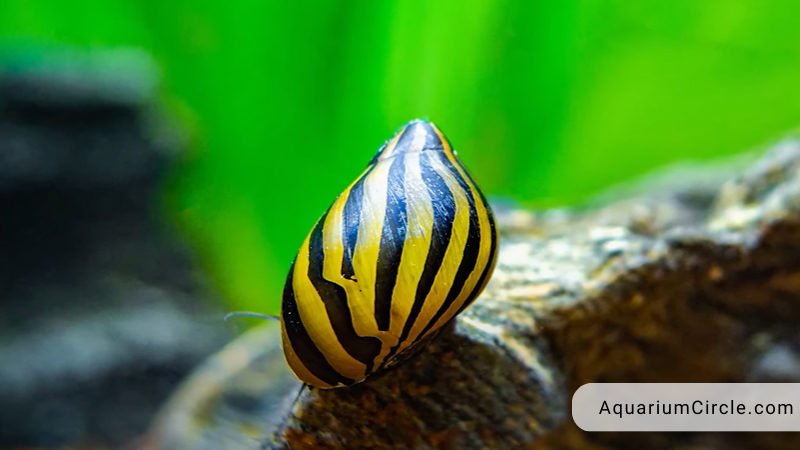
The Nerite Snail is a freshwater mollusk commonly found in aquariums. They are typically kept as pets in freshwater tanks, while in the wild, they inhabit slow-moving streams, lakes, and ponds.
These small, slimy snails can grow up to 5 cm and are an excellent choice for those who wish to maintain a clean tank without much effort.
As herbivores, Nerite Snails consume algae and decaying matter, such as dead plants and leaves. They also eat any uneaten food in aquariums. These charming snails can be fed with algae pellets, cucumber, and other vegetables.
Their appealing colors make them popular among aquarium enthusiasts, and they coexist well with guppy fish.
While Nerite Snails are compatible with guppies, keep in mind that they can reproduce rapidly. As a result, you may find your tank filled with numerous snails within just a few months!
Mystery snails
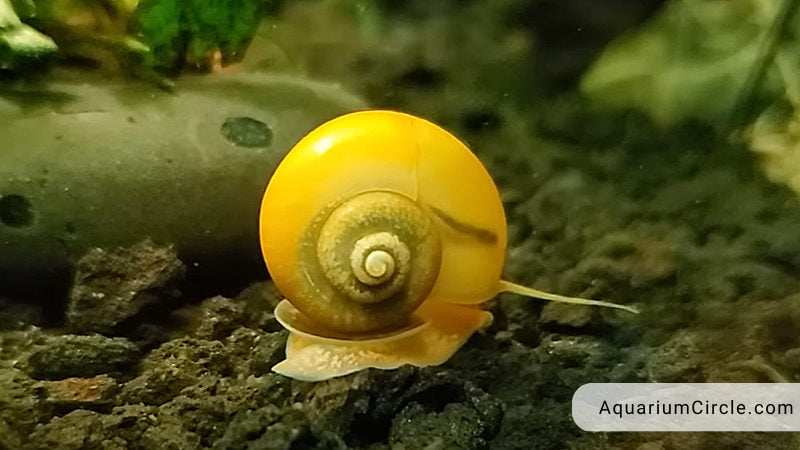
And the last compatible tank mate we recommend in this post is Mystery snails. They are peaceful and non-aggressive, making them a suitable addition to a guppy aquarium. Nerite Snails spend most of their time grazing on algae and detritus, which helps keep the tank clean.
It’s important to note that while Nerite Snails and guppies share similar water parameter requirements, the snails may need a higher pH (7.0 to 8.5) and harder water to maintain healthy shell growth. As long as you maintain appropriate water conditions for both species, they should coexist peacefully in the same tank.
Which Species You Should Avoid Keeping With Guppies
While many fish and aquatic species can live harmoniously with guppies, there are some that should be avoided due to their aggressive nature, predatory behavior, or significant difference in size and habitat requirements. Here are some incompatible tank mates that you should not keep with guppies:
- Large Cichlids: Fish like Oscar, Jack Dempsey, and Convict Cichlids are known for their territorial and aggressive behavior. These cichlids can easily harm or eat guppies and other smaller tank mates.
- Angelfish: Although beautiful and popular, Angelfish can be an aggressive fish and may consider guppies as food, especially when they grow larger.
- Goldfish: Goldfish thrive in cooler water temperatures and require different water parameters than guppies. Also, Goldfish are known to produce a lot of waste, which can affect the water quality for guppies.
- Tiger Barbs: These fish are known for their fin-nipping behavior, which can cause stress and harm to guppies.
- Betta fish (male): Male Bettas are known for their territorial and aggressive behavior, especially towards other colorful and long-finned fish like guppies.
- Red Tail Shark: These fish can become territorial and aggressive, which can lead to conflicts with guppies.
- Chinese Algae Eater: As they grow larger, they can become aggressive and latch onto guppies or other small fish, causing injury or death.
When selecting tank mates for your guppy fish, always consider the size, temperament, and habitat requirements of all species to ensure a peaceful and thriving community tank.
Tips For Introducing New Tank Mates
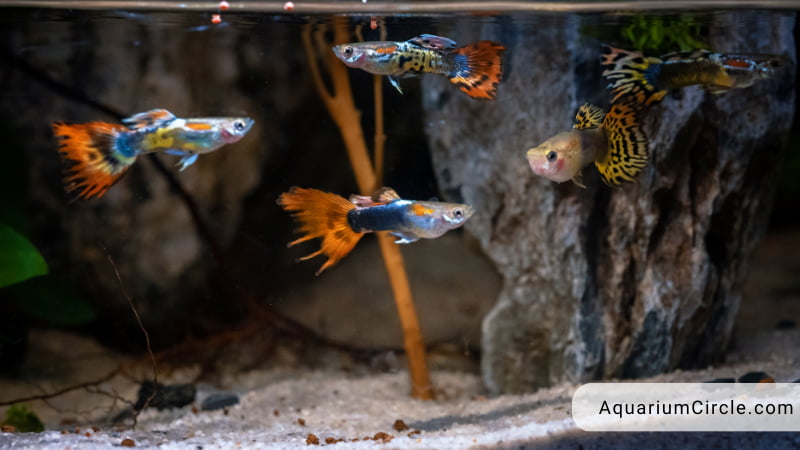
Introducing new tank mates to your guppy aquarium can be a delicate process, as it is essential to ensure compatibility and minimize stress. Follow these tips for a smooth and successful introduction:
- Research Compatibility: Before purchasing any new tank mates, research the species’ compatibility with guppies, considering factors such as temperament, size, and water parameter requirements.
- Match Water Parameters: Ensure that the water parameters, such as temperature, pH, and hardness, are suitable for both guppies and the new tank mates.
- Quarantine New Fish: Always quarantine new fish for at least two weeks in a separate tank to monitor their health and prevent the spread of diseases to your main aquarium.
- Introduce Fish Gradually: To minimize stress, introduce new tank mates one or a few at a time, depending on the size of your tank and the species.
- Rearrange Decorations: Before adding new tank mates, rearrange the decorations and hiding spots in your aquarium to break up established territories and encourage peaceful cohabitation.
- Observe Behavior: Closely monitor the behavior of your guppies and their new tank mates, particularly during the first few days, to ensure there are no signs of aggression or stress.
- Provide Hiding Spaces: Make sure your aquarium has ample hiding spots and visual barriers, such as plants, rocks, and ornaments, so that fish can establish their territories and feel secure.
- Feed Adequately: Offer a variety of food to accommodate the dietary needs of all the species in your tank. Make sure to distribute food evenly across the aquarium to ensure every fish gets their share.
- Maintain Water Quality: Regular water changes and tank maintenance are crucial to maintaining a healthy environment for your fish. Poor water quality can cause stress and make fish more susceptible to diseases.
- Monitor Stocking Levels: Overstocking your tank can lead to poor water quality, increased aggression, and stress among fish. Make sure your tank is appropriately sized for the species you are keeping.
By following these tips, you can create a harmonious community aquarium where your guppies and their new tank mates can thrive together.
See also: How Many Guppies In A 10 Gallon Tank? – 5 Things To Focus
Video About Guppy Tank Mate
FAQs
Can guppy fish live with betta fish?
It is generally not recommended to house guppies with betta fish, as bettas can become territorial and aggressive, potentially attacking the guppies and nipping their fins.
How many tank mates should I introduce with my guppies?
The number of tank mates depends on the size of your aquarium, the species you choose, and their specific needs. As a rule of thumb, consider the inch-per-gallon rule: one inch of fish per gallon of water.
Can guppies live with goldfish?
Guppies and goldfish have different water temperature requirements and are not ideal tank mates. Goldfish produce more waste, which can create an unhealthy environment for guppies.
Can I keep only male or only female guppies in the same tank?
Yes, you can keep either all male or all female guppies in a tank. However, keeping only males may lead to more aggressive behavior, while keeping only females might make the tank less colorful.
How do I know if my tank mates are compatible with my guppies?
Choose tank mates that are peaceful, non-aggressive, and have similar water requirements as guppies. Observe their behavior to ensure they are not stressing or harming each other.
References

Annette M. Chaney is an experienced marine biologist with over 20 years of experience as an aquarist and fishkeeper. She started her first aquarium at a young age, filling it with frogs and goldfish obtained from the ten-cent pet store.
Annette grew up caring for and breeding African Cichlids, which led to a hobby in high school that doubled as a profitable means. Attending Reed College gave her time to solidify herself as an accomplished aquarium caretaker with an eye for sales. After that, from 2009 – 2013, she studied at Roger Williams University – one of the most prestigious universities for Aquaculture and Aquarium in USA. She is the founder of AquariumCircle since 2010.
